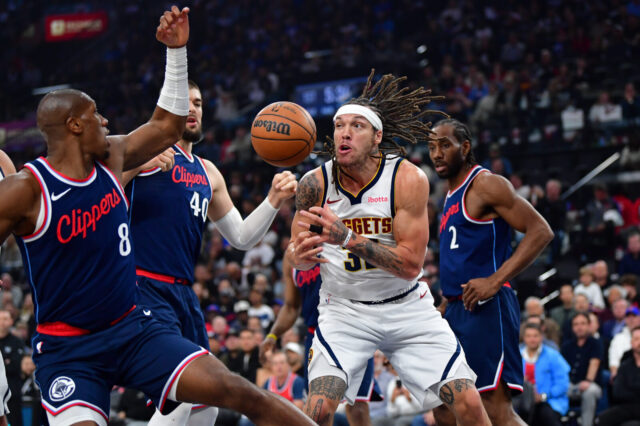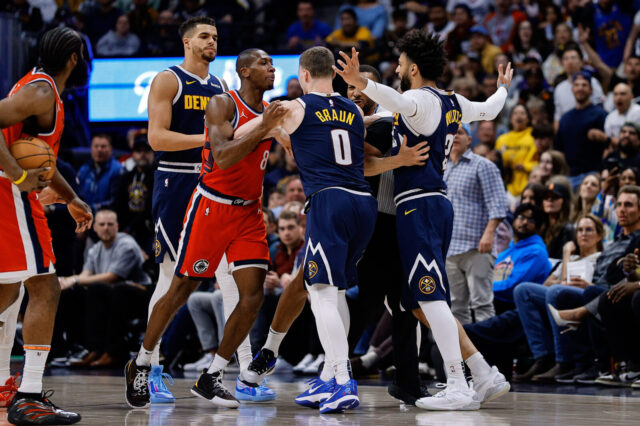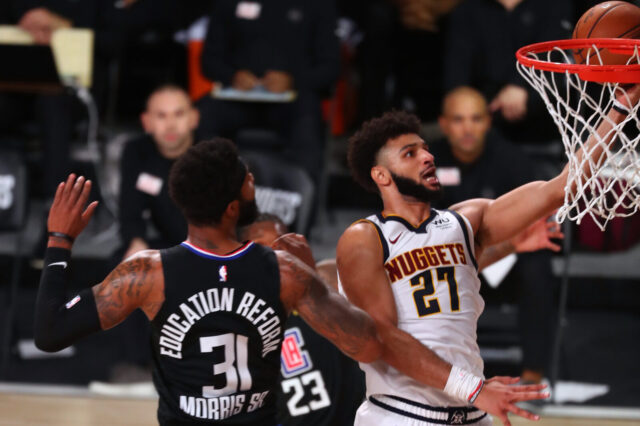The term gravity in the game of basketball refers to how closely a defender is forced to guard a player with and/or without the basketball. It is often thought of in relationship to shooting since great shooters must be guarded closely around the perimeter whenever they are within passing distance of the ball. Players like Steph Curry, for example, can’t be left alone anywhere in the half court since a tiny pocket of space is all that is needs in order for him to get off a very efficient shot. The effect of Curry’s gravity as an off-ball player is that there is one less help defender capable of rotating on any given play and therefore more space in the paint for other players to attack the basket.
Three-point gravity is very important and typically the first thing people think of when they think about basketball gravity, but there are several other types of gravity that can be equally as important for opening up efficient scoring opportunities for the offense. Players like DeAndre Jordan and Anthony Davis have “roll gravity,” meaning their rolls to the rim pull defenders toward the paint (and away from the perimeter) because they are such a threat to finish lobs out of the pick-and-roll. Lebron James has “driving gravity” since he is such an elite finisher at the rim whenever he is able to turn the corner on a screen or get past his man on dribble penetration.
But one under rated type of gravity is “short corner gravity,” which is the unique specialty of Denver Nuggets power forward Kenneth Faried. In the revamped offense the Nuggets have built around the incredible playmaking of Nikola Jokic, Faried has made the short corner his home and elevated the Nuggets offense to unprecedented heights.
First thing to know is what the term “short corner” means. The short corner refers to the area between the corner and the painted area, usually even with or behind the basket. In the image below, Faried is standing in the short corner and his defender, Serge Ibaka, is occupied by his gravity, not wanting to venture too far away.
This content is no longer available.
With Jokic up top as the screener and three perimeter players around the arc, notice how wide open the painted area is for cuts and rolls to the rim. As Emmanuel Mudiay catches the ball off of the Jokic backscreen, he is able to attack the paint and put Ibaka in the unenviable position of having to pick between stepping up to help on Mudiay or stick with Faried in the short corner. Ibaka chooses to help and Faried gets the easy dropoff.
In the next clip, the Nuggets have a similar setup, this time with Faried at the center position. With three shooters around the perimeter and Faried pulling the rim protector into the opposite short corner, Wilson Chandler is able to attack a wide open painted area. Wilson is great at using his combination of size and speed to attack off of the dribble and in this instance, Steven Adams is forced to rotate over to help. Had Faried not been in the opposite short corner – or had he tried to duck in for a post-up as is far too often the case with Jusuf Nurkic – Chandler likely would’ve driven into traffic and either turned it over or forced a contested shot. Instead, Adams is forced to cover too much ground to help and Faried is wide open for the easy dropoff.
Sometimes the defender does not rotate over to help on the drive, opting instead to stick home with Faried in the short corner to prevent the dropoff. But the Nuggets are so perfectly designed to take advantage of that option since Jokic can pass and finish out of the pick-and-roll and players like Danilo Gallinari, Emmanuel Mudiay, and Wilson Chandler are so great at finishing when the paint is clear.
Even if the defense successfully takes away an easy shot at the rim and the dropoff for a dunk, Faried is elite at grabbing the offensive rebound from that spot on the floor. He has the 3rd highest offensive rebound percentage (OREB%) among players to play at least 20 minutes per game, grabbing 15.7% of all reboundable missed shots on offense.
But Faried’s value in the short corner isn’t just about standing still and occupying a defender. Faried actively reads the flow of the offense very well to understand when and how to move without the basketball to maximize his gravity near the baseline. In the clip below, watch how Faried cuts from one short corner to the other, making his cut behind his defender.
Moving behind the defense is important because it accomplishes a couple of things. First, it drags the rim protector deeper toward the rim making it harder to step up and recover or box out. Second, it makes it more difficult for the rim protector to keep track of him since his eyes have to be kept on the ball in front of him in order to track the play.
In the next clip, watch how Faried walks his defender up the paint as he sees Mudiay cutting to the basket. As Mudiay fumbles the ball, Faried immediately clears out of the strong side into the weakside corner, opening up a cutting lane for Jokic. Faried is promptly rewarded for his perfect timing and spacing as Ibaka is forced to step up and help, leaving Faried wide open for the easy flush.
Faried’s short corner gravity is also on display when Jokic (or others) post up. In the clip below, Faried once again displays perfect timing and spacing off of the ball. As his defender leaves him to double the post, Faried steps into a passing lane along the second hash mark. As Jokic goes into his shooting motion, Faried cuts behind the double team for the offensive rebound or dropoff. Jokic makes an incredible read and Faried gets the easy layup. Jokic gets the highlight for the pass but Faried does everything right and makes it very easy for Jokic to make the play.
Lastly, Faried isn’t a great playmaker out of the short corner with the ball in his hands but he seems to understand his strengths and weaknesses very well and almost always plays within himself on offense. Watch how his defender leaves him open to prevent the roll pass to Jokic and how Faried makes him pay by catching the ball on the move and using his quickness to make a one-dribble drive to the basket.
Faried in the short corner also acts as a sort of safety release valve if a drive to the basket doesn’t work. Below, Gallo isn’t able to create separation on the drive and there isn’t a cutting lane for Faried to get open. But with the spacing that this new Nuggets lineup and offensive attack provides, Faried acts as a sort of reset button for Gallo. Handing the ball off for a quick give-and-go.
In last Monday’s win over the Magic, Faried showed off a somewhat new and perhaps underutilized portion of his game: short corner passing. It’s hard to say if incredible passes like the one below are sustainable since Faried isn’t known as an elite passer, but even as a rarely used compliment to his game these types of passes can be very effective. After the game against the Magic, Faried was asked where his great passing recently comes from to which he replied, “It’s chemistry. You start to know each other, know what each other like and you know, watching Nikola helps.”
Faried’s skill in the short corner unlocks so much of what the new-look Nuggets offense is capable of doing. It’s no wonder that the front court pairing of Jokic and Faried is among the best two-man units on the roster and in the realm of the best two-man units in the NBA. The Nuggets have outscored opponents by 76 points in 177 minutes this season when those two are on the court, scoring an absurd 123.8 points per 100 possessions.
Faried’s role has changed as much as anyone’s on the team as he’s bounced from backup forward off of the bench to backup center, starting forward alongside Jusuf Nurkic and now back to starting alongside Jokic. It seems clear at this moment that the team is at their best when he starts alongsde Jokic, both offensively and defensively. The Nuggets are holding opponents to just 103.2 points per 100 possessions, one of the best two-man marks on the team.
Faried has been involved in trade rumors all season but if the Nuggets truly have found their cornerstone piece in Nikola Jokic, Faried is a near perfect running mate on the offensive end of the floor. At the very least, coach Michael Malone and the Nuggets have found the type of power forward that works so perfectly alongside Jokic on the offensive end of the floor.
The Nuggets are just one month into this new point-center experiment. By all accounts, the team is still discovering their identity going forward and figuring out which combinations work best. Here’s to hoping they continue to experiment with more minutes with Faried and Jokic on the court together, taking advantage of Faried’s short corner gravity.


